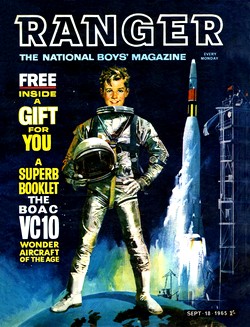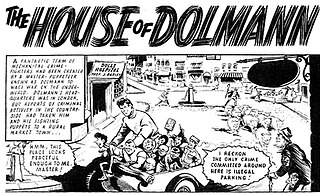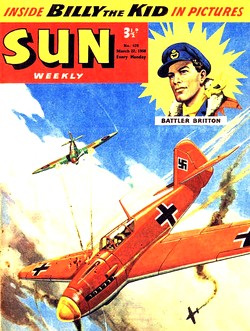
Roy of the Rovers is a British comic strip about the life and times of a fictional footballer and later manager named Roy Race, who played for Melchester Rovers. The strip first appeared in the Tiger in 1954, before giving its name to a weekly comic, published by IPC and Fleetway from 1976 until 1995, in which it was the main feature.

Tiger was a weekly British comics periodical published by Amalgamated Press, Fleetway Publications and IPC Magazines from 11 September 1954 to 30 March 1985. The title was initially launched in a large tabloid size to mimic newspapers; while it featured some action-adventure stories Tiger contained a large number of sport strips. The most famous of these was "Roy of the Rovers", which debuted in the first issue and was the comic's most popular feature, eventually transferring to its own comic in 1975. Tiger would go on to become one of the company's longest-running titles, with 1,573 issues published before being merged with Eagle in 1985. Over the course of its run, Tiger featured columns by numerous famous sports figures, including Ian Botham, Geoff Boycott, Tony Greig, Trevor Francis and Charlie Nicholas.

Ranger was a weekly British comics periodical published by Fleetway Publications from 18 September 1965 to 18 June 1966. Intended as an educational publication, the cover described it as "The National Boys' Magazine" and the content mixed comic strips with a much larger quotient of factual articles than most other Fleetway children's titles of the time. Ranger lasted 40 issues before being merged with Fleetway's fellow educational title Look and Learn in 1966.

Tom Tully was a noted British comic writer, mostly of sports and action-adventure stories. He was the longest-running writer of the popular football-themed strip Roy of the Rovers, which he wrote for much of Roy Race's playing career until the weekly comic closed in 1993. Other notable strips penned by Tully included The Steel Claw, The House of Dolmann, The Incredible Adventures of Janus Stark, The Leopard from Lime Street, The Robo Machines, and Harlem Heroes. During his three-decade career, Tully wrote exclusively for what became known as the IPC line of publishers: Amalgamated Press/Odhams/Longacre Press/Fleetway/IPC Magazines.

Lion was a weekly British comics periodical published by Amalgamated Press from 23 February 1952 to 18 May 1974. A boys' adventure comic, Lion was originally designed to compete with Eagle, the popular weekly comic published by Hulton Press that had introduced Dan Dare. It debuted numerous memorable characters, including Captain Condor, Robot Archie, Paddy Payne and the Spider. Lion lasted for 1,156 issues before being merged with stablemate Valiant.

Valiant was a weekly British comics periodical published by Fleetway Publications and later IPC Magazines from 4 October 1962 to 16 October 1976. A boys' adventure comic, it debuted numerous memorable characters, including Captain Hurricane, The Steel Claw and Mytek the Mighty. Valiant lasted for 712 issues before being merged with stablemate Battle Picture Weekly.

The Comet was a weekly British comics periodical published by J.B. Allen and later Amalgamated Press and Fleetway Publications from 20 September 1946 to 17 October 1959. Initially a children's newspaper, The Comet was transformed into a boys' adventure comic in May 1949 by editor Edward Holmes when J.B. Allen were purchased by Amalgamated Press. Also known as Comet Comic, The Comet Adventure Weekly, Comet Weekly and simply Comet as various points the title continued until October 1959, reaching 580 issues before being merged with another AP boys' comic, Tiger.

Vulcan was a British weekly boys' comic published by IPC Magazines from 1 March 1975 to 3 April 1976, when it merged with Valiant. The comic was unusual among IPC's weeklies for several reasons - it used a much smaller format than most of the company's weeklies and featured more colour; until September 1975 the title was only available in Scotland as the format was tested; and it consisted entirely of reprints of extant material. It was also published simultaneously in German as Kobra.

"The House of Dolmann" is a British comic strip published by Fleetway Publications and later IPC Magazines in the boys' comic anthology title Valiant between 29 October 1966 to 11 April 1970, with a brief revival from 7 September to 26 October 1974. Written by Tom Tully and primarily illustrated by Eric Bradbury, the strip centred on the exploits of genius inventor Eric Dolmann and his army of crime-fighting robot 'puppets'.

Odhams Press was a British publishing company, operating from 1920 to 1968. Originally a magazine publisher, Odhams later expanded into book publishing and then children's comics. The company was acquired by Fleetway Publications in 1961 and then IPC Magazines in 1963. In its final incarnation, Odhams was known for its Power Comics line of titles, notable for publishing reprints of American Marvel Comics superheroes.

Captain Condor is a British comic character who has appeared in eponymous strips published by Amalgamated Press and Fleetway Publications. The character, a space pilot, first appeared in the launch issue of weekly comic Lion on 23 February 1952 and was created by Frank S. Pepper.
Battler Britton is a British comics character created by Mike Butterworth and Geoff Campion. He first appeared in Amalgamated Press' Sun in 1956, and later featured in Knockout, and the long-running digest titles Thriller Picture Library, Air Ace Picture Library, and War Picture Library.

Sun was a weekly British comics periodical published by J. B. Allen, Amalgamated Press and Fleetway Publications between 11 November 1947 and 17 October 1959. During this time it was also known as Sun Comic, Sun Adventure Weekly, The Cowboy Sun Weekly, The Cowboy Sun, The Sun and Sun Weekly at various points, and ran for 551 issues before merging with Lion.

Thunder was a weekly British comics periodical published by Fleetway Publications from 17 October 1970 to 13 March 1971. A boys' adventure comic, the title only lasted for 22 editions before being merged with another Fleetway title, the long-established Lion.

"Gadgetman and Gimmick-Kid" is a British comic strip published by Fleetway Publications in the boys' comic anthology title Lion between 4 May to 26 October 1968. Written by Superman co-creator Jerry Siegel, it tells the adventures of a pair of American crime-fighting technical geniuses - Gadgetman and his younger sidekick Gimmick Kid - as they battle a variety of outlandish villains.

Jet was a weekly British comics periodical published by Fleetway Publications from 1 May to 25 September 1971. A boys' adventure comic, the title only lasted for 22 editions before being merged with another Fleetway title, the long-established Buster.

Cursitor Doom is a fictional British comic book character who debuted in a self-titled comic strip in the 15 March 1969 issue of the anthology Smash!, published by IPC Magazines. Created by Ken Mennell, Cursitor Doom is a powerful mystic who protects Earth from supernatural threats.

Hurricane was a weekly British comics periodical published by Fleetway Publications from 29 February 1964 to 8 May 1965. The title was billed as "the companion paper to Valiant" in reference to the weekly launched by Fleetway in 1962 that had rapidly become one of the company's best-selling publications. However, while Valiant would run until 1976, Hurricane was less successful and lasted just over a year before being merged with Tiger in 1965.

"The Indestructible Man" is a British comic strip published by Fleetway Publications and later IPC Magazines in the boys' comic anthology title Jag between 4 May 1968 to 29 March 1969. Written by Scott Goodall and drawn by Jesús Blasco, the story followed an Ancient Egyptian warrior who survived into the present day after learning a number of skills while entombed, and took on the identity of crime-fighter Mark Dangerfield.

















